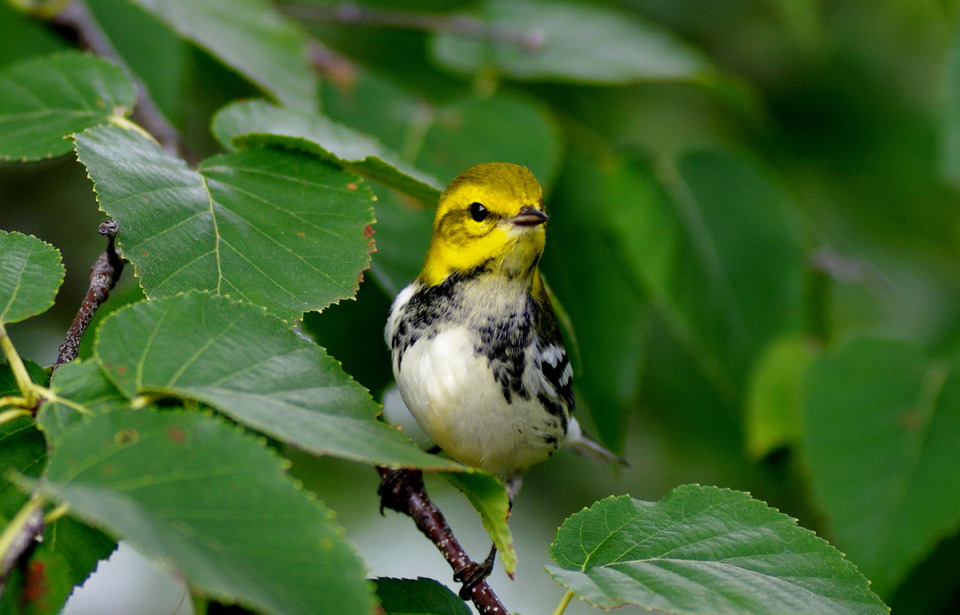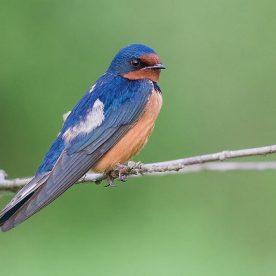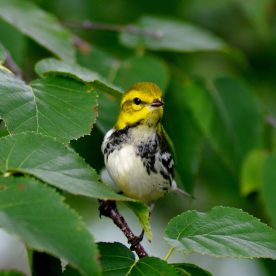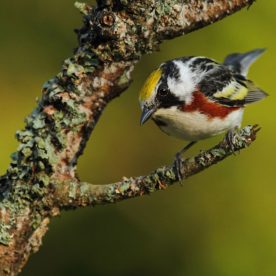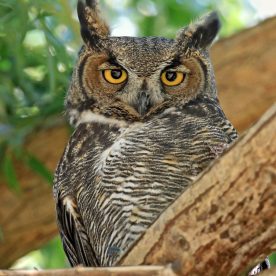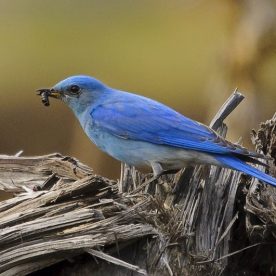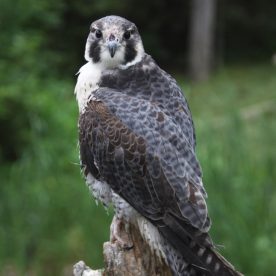Pesticides and Wild Birds
Chemical pesticides
- are often used unknowingly by Canadians in products such as outdoor paints and wood preservatives, disinfectants, and flea collars
- do not recognize specific targets and may kill species that people wish to keep as well as those that they label as “pests”
- may be contacted by birds in many ways—including by mistaking them for food or drink and absorbing them through the feet
- include more than 30 products registered for use in Canada that can poison wild birds
What are pesticides?
Pesticides are considered by many to be essential to our everyday existence, or, at least, to our current standard of living. They have saved countless lives by reducing the impact of diseases that are transmitted by mosquitoes and other insect pests, such as typhus and malaria. They also play a major role in humankind’s efforts to grow and store enough food to feed itself.
The vast majority of Canadians are indirect consumers of pesticides through the food they buy. Many use pesticides directly, often without realizing it: outdoor paints and wood preservatives, disinfectants, and flea collars, for example, contain pesticides.
Despite their usefulness, there is ample evidence that pesticides worldwide are being overused and misused. Most concern centres on the potential health effects of pesticide residues in our food and on the risk of harm to pesticide applicators. The damaging effects of pesticides on our wildlife species and their habitat, on the other hand, are not generally recognized.
This fact sheet is about birds and how they are being affected by pesticides. Occasionally, pesticides are used specifically to protect birds and their habitat—or example, to control damaging species that have been introduced, accidentally or intentionally, into the birds’ environment. More often, however, birds are innocent victims in our relentless war against species that compete with us.
Are birds in trouble?
Like the proverbial canary in the coal mine, many of our bird populations are showing signs of trouble. Although a few species have clearly benefited from the human presence, those species that inhabit our farmland and other open areas are more likely than other species to be in decline. This trend is even more extreme in Europe, where the majority of common farmland birds are decreasing. The declines have been blamed not only on habitat loss, but also on agricultural intensification, in which pesticides play a key role.
The word pesticide means “pest killer.” Legally, the term includes chemicals, organisms, and devices designed to destroy, attract, or repel pests. A pest is any organism that is unwanted by humans at a specific time or in a specific place. The ancient Romans and Chinese, among others, used various minerals and plant extracts to kill or repel insects and to attack fungi that caused plant disease. Widespread use of manufactured chemical pesticides began in the 1930s and dramatically increased after World War II.
How pesticides work
Pesticides are grouped according to the pests they control. For example, insecticides are used against insects, such as mosquitoes and other biting flies, as well as agricultural, forest, turf, and household pests; herbicides are used against unwanted plants on rights-of-way, lawns, golf courses, and cropland, as well as in orchards and tree plantations;fungicides are used against fungi, which cause many plant diseases and plant rot; and rodenticides are used against rodents, such as rats, mice, and voles in buildings and orchards.
Pesticides are sold in many forms, such as aerosols, granules, baits, and powders or concentrates that are mixed with water and applied as liquids. They may be applied in a variety of ways, including being sprayed from an airplane or from a sprayer pulled behind a tractor, dissolved in irrigation water, buried in the soil, sprinkled as granules or pellets on the ground next to plants, applied as a coating on seeds, or inserted into livestock collars or into bait material.
A pesticide’s form determines how a bird may come into contact with it—by mistaking it for food or drink, absorbing it through the feet, inhaling it, or rubbing against a contaminated surface and then ingesting it while preening its feathers. Granular pesticides (mixed with clay, sand, or dried pieces of corn cob) are especially hazardous to pecking birds, because the birds may mistake the granules for food or grit, which they use to grind their food.
A pesticide works by disrupting a vital bodily process, such as photosynthesis in plants, or by destroying a major organ, such as a caterpillar’s intestine. Organophosphates and carbamates, the most common insecticides in use today, are known as “cholinesterase-inhibiting pesticides,” because they kill by interfering with an enzyme vital for nerve transmission. Pest populations exposed to repeated applications of a pesticide may evolve genetic resistance to it, so that the pesticide no longer works.
Pesticides do not actually “recognize” target pest organisms. They are “programmed” to affect a process or organ, and any organism that has such a process or organ can be affected. Thus, a pesticide may kill species that people wish to keep as well as species that they label as “pests.” To limit the number of nontarget species at risk, it is wise to useselective pesticides (those that affect only one group of pest organisms, such as flies) rather than nonselective pesticides (those that are toxic to a broad range of organisms, such as mammals, birds, fish, and insects). The selectivity of a pesticide is therefore key to its ecological impact.
Pesticide use
In Canada, more than 30 registered pesticides can poison wild birds. Most of these are the cholinesterase-inhibiting organophosphates and carbamates. These insecticides work well against a broad range of insects and are often less expensive than many alternatives, which adds to their popularity. Unfortunately, they are acutely (immediately) toxic and not very selective, affecting most types of animals. They also break down quickly in water or soil, which means that they often need to be applied to crops more than once per growing season. When accidentally eaten by or absorbed into the body of a wild animal, they are detoxified rapidly and excreted, or eliminated from the body—unless, of course, the animal dies first. Mammals are much better than birds at detoxifying organophosphates and carbamates. For example, birds are 100 times more sensitive than mammals to the common insecticide diazinon.
Organochlorine insecticides, such as DDT, also work well against a broad range of insects, but they remain toxic much longer. Although most organochlorines were discontinued in Canada in the 1970s after causing population declines in Peregrine Falcons and other bird species, traces are still found in the environment (particularly in areas of former heavy use, such as orchards) and in wildlife. A dose that was effective against insects was not necessarily directly toxic to birds; however, because the pesticides persisted for decades and accumulated in the food chain, it was possible for birds, especially predatory species, to accumulate a lethal dose over time. Persistent organochlorines are still legally used in some southern hemisphere countries visited by Canadian migratory birds.
Which pesticides are less toxic to birds?
Some pesticides are much more “target-specific” and less toxic to birds. They still need to be used with caution, however. For example, synthetic pyrethroids are not generally acutely toxic to birds or mammals and are therefore more selective than the organophosphates or carbamates. However, they are particularly toxic to fish, amphibians, and terrestrial and aquatic invertebrates. Selectivity is often a relative concept.
Microbes that are specific to the pest or to a small number of related insects as well as insect predators or insect parasites released in large numbers to prey on a particular pest are usually the most target-specific of all insect control options. They result in the least amount of disruption to the natural environment. One microbe commonly used against insect pests is Bacillus thuringiensis kurstaki (Btk), a bacterium that destroys caterpillar intestines. Caterpillar “pests” include the gypsy moth, spruce budworm, and European corn borer.
Most herbicides and fungicides are also not acutely toxic to birds or other animals. However, several have been shown to interfere with reproduction in birds in laboratory studies (although not yet in the field). In addition, several herbicides and fungicides are toxic to fish and earthworms, so there may be less food-rich habitat available to some birds after their use.
Which birds are most vulnerable?
Some birds are more likely than others to be exposed to pesticide residues. One group at risk is birds that eat large quantities of foliage that might have been recently sprayed, such as waterfowl and game birds. Another group at risk is seed-eating songbirds, which are attracted to insecticide granules and pesticide-treated seeds. Species that gorge on pest insects, such as grasshoppers, are particularly vulnerable in times of pest outbreak. Finally, scavengers and predators that take slow or disabled prey are at a high risk of ingesting other birds or mammals that have been poisoned.
How are birds affected?
Pesticides can kill birds directly, poison them without killing them directly, or affect them by reducing their food or habitat resources.
Lethal poisoning
Insects and vegetation sprayed with insecticides can contain sufficient residues to kill hungry birds. Die-offs, like those described in Box 1, can happen, even when pesticides are applied responsibly, following the instructions on the label—hence the importance of monitoring product performance and reporting problems. It takes only one or two small granules of the more toxic organophosphate or carbamate insecticides to kill a small bird. As well, sufficient quantities of pesticide residues remain in the stomachs of poisoned birds and mammals to kill predators and scavengers, such as eagles and crows.
Sublethal poisoning
Not all poisonings result in immediate death. A poisoned bird may lose weight, increasing its chances of dying from other stresses, such as bad weather. It may sing less and fail to attract a mate or defend a territory. It may raise smaller broods, provide less food for its chicks, or exhibit abnormal behaviour towards its mate. A weakened bird may also be less able to escape from or defend against predators.
Impacts are not always easy to predict. Songbirds nesting in grassland sprayed with the toxic insecticide carbofuran have survived and successfully reared their young, although gulls have perished and Burrowing Owls have abandoned their nests and disappeared under the same circumstances (see box, below). Survival is likely due to the ability of some species to eliminate the insecticide from the body before a lethal or debilitating dose is acquired.
Examples of mass poisoning of Canadian birds by pesticides
There are relatively few well-documented cases of mass pesticide poisoning of birds, at least in Canada. To some, this indicates that such events are rare; others point to the inaccessibility of farm fields and treated forests, the rapid disappearance of carcasses after a kill, and the general lack of monitoring for such events. Mass poisonings need not be spectacular—they may involve large numbers of widely distributed birds. Kills of small birds are seldom reported—yet we know that, on average, they are at higher risk of poisoning. In the United States, where the reporting rate is thought to be better than in Canada, a pesticide kill is reported, on average, every two weeks for birds of prey alone. Whether bird poisonings in Canada are frequent enough to contribute to current population declines is an open question. Between June 1986 and September 1988, at least five cases of poisoning of flocks of Canada Geese were recorded on southern Ontario golf courses and in other grassy areas. The birds died within minutes of swallowing grass sprayed with the insecticide diazinon. Large kills (up to 700 in a single kill) of Arctic-nesting Brant geese were routinely observed on the golf courses of Long Island, New York, before the pesticide’s use on golf courses was banned in the United States. Diazinon is still used extensively on Canadian golf courses and as a “home and garden” insecticide. After a Saskatchewan farmer applied granules of carbofuran to control flea beetles in a canola field in 1984, he returned to find the bodies of several thousand Lapland Longspurs dotting the field. These Arctic migrants travel in flocks numbering tens of thousands. During migration, they are vulnerable to pesticides used on farms, because they favour recently seeded fields and spend much of their time pecking at the ground in search of food. The Canadian Wildlife Service (CWS) is currently in discussion with the registration authorities over the continued use of this product. The years 1984 to 1986 were bad grasshopper years in the Canadian prairies. At least three cases of poisoning of Ring-billed and California gulls were reported when the gulls attempted to feed on grasshoppers sprayed with carbofuran. CWS-sponsored research showed that colonies of the endangered Burrowing Owl were abandoned when this chemical was used nearby. As of 1998, this insecticide can no longer legally be used against grasshoppers. Numerous less toxic alternatives are registered. In late 1995 and early 1996, more than 4 000 carcasses of Swainson’s Hawks, some with bands showing that their breeding grounds were in Canada, were counted in the farm fields of Argentina. Farmers had sprayed organophosphate insecticides, including the very toxic monocrotophos, to control a grasshopper outbreak. Although precise counts were not possible, the total kill was conservatively estimated at over 20 000 hawks. Such die-offs may be contributing to a recent decline of this species. CWS is assisting the Argentine government with measures intended to reduce the probability of future kills. Between 1990 and 1996, a third of the 100+ Bald Eagles taken dead or moribund to raptor rehabilitation centres in the Fraser delta of British Columbia had been poisoned by pesticides. They were exposed through scavenging of waterfowl poisoned by granular insecticides in nearby fields. Kills were recorded with the insecticides fensulfothion, carbofuran, phorate, terbufos, and fonofos. Spraying forests of eastern Canada with a number of insecticides, including the organophosphates phosphamidon (1963 to 1977) and fenitrothion (1969 to 1997), was the main strategy employed to reduce the defoliation caused by spruce budworm. Phosphamidon was found to result in heavy mortality and massive reductions in the numbers of kinglets and several warbler species. It was nicknamed “purple death” and noted for the eerie silence that followed its use. Although the impact of fenitrothion was considerably less, it was still found to kill and seriously impair birds in treated areas. Because of the scale of the spray program, which peaked at 3.9 million hectares during the budworm outbreak in the 1970s, even this lesser impact was judged to be unacceptable, and alternative insecticides are now used. Toxic perches loaded with the organophosphate fenthion to kill pest birds have been responsible for at least 15 kills of birds of prey in the last 10 years in the United States. Several endangered Peregrine Falcons are known to have been killed by this product. CWS-sponsored research has shown that birds of prey capturing exposed sparrows or pigeons will die and that debilitation of the pest bird makes capture likely. Cases have yet to be reported from Canada, although the product is registered in our country.
Food and habitat loss
Do we use a lot of pesticide products in Canada?
Although the intensity of pesticide use is lower in Canada than in many other industrialized countries, pesticides are used extensively. In the 1980s, herbicides were used on 67 percent of Canadian cropland, and insecticides and fungicides on 11percent. Forestry and nonagricultural uses (e.g., golf courses) add significantly to the total area treated with pesticides.
In most industrialized countries, herbicides are used much more heavily than other pesticides. The target “weeds” (such as lambsquarters), the nontarget plants that happen to be sensitive to the herbicide used, and the protein-rich insects that live on these plants are all essential food to birds, whether breeding adults or their broods. Pesticide use affects food production in other ways, as well. Seed set and berry production are reduced if pollinating bees are killed by pesticides. Pesticide pollution of wetlands reduces the “crop” of aquatic insects essential to the growth and development of aquatic birds. The use of insecticides on lawns reduces the number of earthworms, which in turn affects American Robins.
The use of pesticides on farmland has further reduced the amount of safe habitat available for birds that already have to make do with small woodlots, hedgerows, shelterbelts, and farm ponds for nesting or feeding. Even habitats bordering agricultural fields can become a liability if birds are attracted into the fields and then inadvertently poisoned by toxic insecticides. Herbicide use, such as in forestry, may cause ground-dwelling birds to lose the leafy shelters that protect them against predators and bad weather. The potential for the herbicide spray to drift through the air and contaminate distant wetlands through water runoff is also a concern.
Herbicides and habitat
One of the best scientific studies of the ecological effects of herbicides in a farming area was done in Britain. It traced how controlling farmland weeds affected the common Grey Partridge. After spraying, some plants disappeared, and so did insects once found among the leafy growth. Hungry chicks, which depend on insects during the first weeks of life, were forced to roam farther to find food. This depleted their strength and made them more vulnerable to harsh weather and predators. The population was dealt a further blow when hedgerows were cut down, wiping out good nesting sites.
Understanding the effects
Pesticides have not yet caused any bird species to become extinct in Canada, although Peregrine Falcons almost died out in eastern Canada in the 1960s before the government phased out DDT and other organochlorines. However, only a small proportion of current pesticide bird kills are documented. Many poisoning incidents are not reported because the poisoned birds hide and the carcasses quickly decompose or are eaten by scavengers. Also, some pesticide losses are misdiagnosed as cases of electrocution or trauma.
Canadian researchers are only beginning to understand the overall effects of pesticide use on bird abundance and diversity. Could pesticides affect a keystone species — one that plays a vital role in the ecosystem — with hard-to-predict consequences for wildlife? It is not always possible to unravel the effects of pesticides from the effects of the many other factors that contribute to the pollution and loss of habitat that threaten some wildlife species. Although British studies suggest that changes to habitat after the use of herbicides may have more serious consequences for some bird populations than direct losses through pesticide poisoning, it is unclear whether this applies to North America, where our use of highly toxic insecticides tends to be higher.
Protecting birds
Responsible pesticide use
Pesticides should be used only as a last resort. It is possible to reduce our dependence on pesticides. “Integrated pest management” combines the use of some chemical pesticides with alternative methods. Environmentally responsible farmers, foresters, landscapers, and gardeners explore such alternatives as growing pest-tolerant plant species, rotating crops, planting companion crops, releasing (after careful study) insects and microbes that prey on the pest, and encouraging bird and insect species that provide natural pest control, as well as learning to profit from selected weed species. They also measure their fertilizer needs carefully, using manure and compost to replenish the soils: good soil produces healthy, robust crops that better resist pests. As an added benefit, reducing pesticide use means that it will take longer for pest populations to develop resistance, so that the pesticides will be effective when needed.
Responsible pesticide use includes using a registered product; reading and following the directions on the label when using any pesticide; using a selective pesticide rather than a nonselective one; using the least amount needed to do the job; including the indirect (ecological) costs of pesticide use when calculating the benefits and costs of pesticide use; finding out whether the active ingredient (the ingredient that actually kills the pest) identified on the label affects birds, and avoiding its use during the season when vulnerable birds may be exposed; using pesticides at a strength and in a form least likely to affect birds and other wildlife; avoiding the contamination of wetlands and water; and reporting wildlife problems associated with pesticide use. Only through reporting will it be possible to weed out problem chemicals.
The extent to which our society depends on pesticides is eventually up to us. You can help by learning more about how various pesticides work and how they affect ecosystems—in other words, by finding out about the costs as well as the benefits of pesticide use. As a consumer, insist that pesticides particularly dangerous to wildlife not be used, and avoid using them yourself.
Government protection
In Canada, pesticides must be registered federally by the Pest Management Regulatory Agency (PMRA) under Health Canada (PMRA information line: 1-800-267-6315). The sale and use of pesticides are further controlled by provincial legislation. Regulators primarily assess the toxicity of the active ingredient to humans; they predict its toxicity to wild and domestic organisms based on laboratory tests on a few indicator species. As there are hundreds of pesticide products sold in Canada, hundreds of species of birds, and tens of thousands of wildlife species, wildlife toxicologists—scientists who study the effects of poisons on wild plants and animals—focus mainly on troubleshooting.
If, after its release, a registered pesticide is proven to cause serious environmental impacts, the product can be further restricted or banned, or it can be withdrawn voluntarily by the manufacturer. It is difficult to prove that a pesticide (particularly one that breaks down quickly) was responsible for the death of a bird or other wild organism. Researchers depend on citizen reports of suspicious deaths of wild birds or other wild organisms associated with pesticide use to alert them to a potential problem.
Please report wildlife problems associated with pesticide use in writing to:
Pesticide Section
National Wildlife Research Centre
Canadian Wildlife Service
Environment Canada
Ottawa, Ontario K1A 0H3
Fax: (613) 998-0315
In cases that require immediate attention, contact the National Information Line of the Canadian Cooperative Wildlife Health Centre at 1-800-567-2033.
Resources
Print resources
The Canadian Wildlife Service conducts research on the impact of pesticides on birds and other wildlife species. A brief summary of this research, as well as selected titles of scientific publications, can be obtained by writing to the above address or by visiting the Environment Canada website.
© Her Majesty the Queen in Right of Canada, represented by the Minister of the Environment, 1998. All rights reserved.
Catalogue number CW69-4/98-1998E
ISBN 0-662-26641-2
Text: Pierre Mineau
Drawings: Roelof Idema for the Canadian Wildlife Service
Photos: Canadian Wildlife Service



